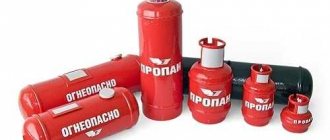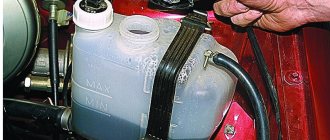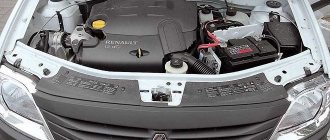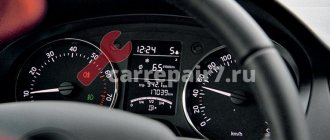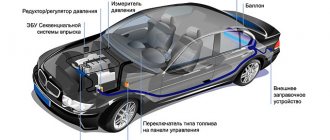How long will a gas cylinder burn?
On average, a bottle lasts for 2-3 days. In order not to wake up in a cold house, you can purchase a gas ramp and connect several propane cylinders: 2 main and 2 backup, for example, or you can purchase an RP-2 cylinder unit.
Interesting materials:
What promotes muscle growth? What promotes collagen production? What promotes melatonin production? What stimulates hormone production? What are the limits for waste disposal? Answer? What is included in administrative costs in Ukraine? What is included in proteins and carbohydrates? What's included in Doom Eternal Deluxe Edition? What's included in Injustice 2 Legendary Edition? What is included in travel expenses 2022?
Physical meaning of translation
In a physical sense, everything is quite simple. The translation is carried out in the same way for any gases, liquids or bulk materials as follows:
- 1 cubic meter contains 1000 liters,
- 1 liter equals 0.001 cubic meters
- the table shows the quantity contained in 1 cube (1 cube = 1000 cubic decimeters, etc.).
For example, 15 cubic meters of natural gas used by the meter equals 15,000 liters. When converting these values, the temperature of the fuel, the amount of impurities and other factors do not matter.
Summary
If gas consumption is high, for example, during the gasification of a large industrial facility, you should first of all find all possibilities for connecting to the gas main. Although this may require much more expense than installing gas tanks and related equipment, the costs will be recouped over time due to the low price of fuel.
With moderate gas consumption, for example, when gasifying a private house, a small village, a farm, a small and medium-sized industrial enterprise, an autonomous system using gas tanks would be a more reasonable solution.
14 Feb 2017
Tariffication of heating in Kemerovo
Heating tariffs in the city of Kemerovo have changed significantly over the past few years. Currently, this tariff is calculated based on the actual amount of hot water consumption by the population of the Kemerovo region and the city of Kemerovo in particular. The heating system includes direct thermal energy, as well as its conductor, which is water circulating through the batteries.
The cost of heating in the Kemerovo region depends on such metrics as:
- price of cold water;
- price of thermal energy;
- internal expenses of the management company
How does a liter compare to a cubic meter?
The liter is a measure of capacity that is not included in the international SI system, but is used very widely. Moreover, it is the liter, and not the “abstract” cubic meter, that is the most common unit of volume measurement in everyday life. For example, it is measured in liters:
- capacity of various vessels intended for household use (buckets, pans, bottles, canisters, containers);
- trunk volume of passenger cars,
- internal volume of refrigerators, freezers, microwaves and ovens;
- capacity of city and tourist backpacks.
The "official" definition of a liter has changed several times. From the beginning of the 20th century until 1964, according to the decision of the General Conference on Weights and Measures, a liter was defined as the volume occupied by a kilogram of water. However, this definition turned out to be not very convenient: the ratio of the volume and mass of a liquid depends on many factors - from atmospheric pressure to air humidity. Therefore, experts abandoned the “reference” to the mass of water. And now a liter means a volume that exactly corresponds to a cubic decimeter - the volume of a cube, each edge of which has a length equal to exactly 10 centimeters, which corresponds to 0.1 meters.
Calculation example
Calculator for converting liters of liquefied gas to kilograms (kg)
To understand how many liters are 1 cubic meter of water and learn how to calculate meter readings, just look at a practical example:
At the end of September, the meter showed 00021889, a month later - 00045346. The first numbers after the zeros are cubic meters, they are subject to rounding. It turns out 45 and 22 respectively.
45 – 22 = 23 cubes used.
The receipts show the cost of 1 cubic meter. water. It must be multiplied by the result obtained. For example, at a price of 35 rubles. the result is as follows:
23 x 35 = 805 rub.
According to this scheme, the “cubes” of both hot and cold water supply are calculated.
Use of liquefied gas
It’s a little more complicated with liquefied gas. It is widely used:
- in modern industrial production;
- in thermal and electric power engineering;
- as a reserve stock during the period of the most intensive consumption by the population;
- as a replacement for traditional gasoline or diesel fuel for road transport;
- for domestic purposes.
We recommend: Procedure for replacing an electricity meter
In the household, it is advantageous to use liquefied gas in cylinders for the operation of gas-consuming household appliances, provided there is no centralized supply line.
Various mixtures of propane and butane are used for liquefaction. The use of methane is not economically profitable, since at room temperature the pressure in the system increases so much that to ensure safety it is necessary to create containers with large wall thicknesses and use materials of increased strength.
The change in gas volume during the transition from the liquid phase to the gaseous phase is determined by the following factors:
- chemical composition;
- pressure;
- temperature;
- density and specific gravity.
To calculate the number of liters of liquefied gas per cubic meters of fuel that have turned into a gaseous state, it is necessary to use the specified characteristics. But since it is difficult to reliably establish the exact composition of the mixture in the cylinder, it is necessary to be guided by an approximate ratio, according to which at a standard temperature of 20 degrees, 1 liter of liquefied gas will produce 200 - ordinary gas. Therefore the formula applies:
Okub = Ol/5
Where:
- Cube – volume in cubic meters;
- Ol – volume in liters.
We recommend: Sensors for detecting gas leaks
When making calculations, it is necessary to additionally take into account that, for safety reasons, gas cylinders are filled to no more than 85 percent of the total volume.
Molecular weight - common substances
The molecular mass of a substance, also called molar mass, M, is the mass of 1 mole of that substance, expressed in M grams.
In the SI system the unit of M is [kg/kmol], and in the English system the unit is [lb/lb-mol], while in the CGS system the unit of M is [g/mol]. Molecular weight is represented by the same number in all systems of units, regardless of the system used. For this reason, in many cases the molecular weight unit is not specified; however, it should be understood that this is not a dimensionless parameter.
The molecular weight of a pure compound is determined by its chemical formula and the atomic weight of its elements. The atomic weights of elements found in organic matter are C=12.011, H=1.008, S=32.065, O=15.999 and N=14.007.
Example: Molecular weight of ethanol (C 2 H 5 OH) To calculate the molecular weight of ethanol, the molecular weight of each atom in the molecule is summed:
M ethanol = 2 * 12.011 [kg/kmol] + 6 * 1.008 [kg/kmol] + 1 * 15.999 [kg/kmol] = 46.069 [kg/kmol]
See also Physical Data for Hydrocarbons, Physical Data for Alcohols and Carboxylic Acids, Physical Data for Organic Nitrogen Compounds, and Physical Data for Organic Sulfur Compounds
| Substance | Molecular mass [kg/kmol] [g/mol] [lb/lb-mol] | ||
| Acetylene, C 2 H 2 | 26.038 | ||
| Air | 28.966 | ||
| Ammonia (R-717) | 17.02 | ||
| Argon, Ar | 39.948 | ||
| Benzene | 78.114 | ||
| n - Butane, C 4 H 10 | 58,124 | ||
| 1.2 - Butadiene | 54,092 | ||
| 1-butene | 56,108 | ||
| cis-2-butene | 56.108 | ||
| trans-2-butene | 56.108 | ||
| Butylene | 56.06 | ||
| Carbon dioxide, CO 2 | 44. 01 | ||
| Carbon disulfide | 76,13 | ||
| Carbon monoxide, CO | 28,011 | ||
| Chlorine | 70,906 | ||
| Cyclohexane | 84,162 | ||
| Cyclopentane | 70.135 | ||
| n - Dean | 142,286 | ||
| Deuterium | 2,014 | ||
| 2,3 - Dimethylbutane | 86,178 | ||
| 2,2 - Dimethylpentane | 100,205 | ||
| Diisob45 114.232 | |||
| Duoderan | 170,21 | ||
| Ethane, C2H6 | 30,070 | ||
| Ethen | 28.05 | ||
| Ethanol | 46,07 | ||
| Ethylbenzene | 106,168 | ||
| Ethyl chloride | 64,515 | ||
| 3 - Ethylpentane | 100,205 | ||
| Ethylene18H2 | 28,054 | ||
| Fluorine | 37,996 | ||
| Helium, He | 4,002602 | ||
| n - Heptane | 100. 205 | ||
| n - Hexane | 86,178 | ||
| Hydrochloric acid | 36,47 | ||
| Hydrogen, H2 | 2,016 | ||
| Hydrogen chloride | 36,461 | ||
| Hydrogen sulfide | |||
| Hydroxyl, OH | 17,01 | ||
| Isobutane (2-methylpropane) | 58,124 | ||
| Isobutene | 56.108 | ||
| Isooctane | 210,63 | ||
| Isopentane | 72,151 | ||
| Isoprene | 68,119 | ||
| Isopropylbenzene | 120,195 | ||
| Methyl alcohol | 32,04 | ||
| Methylbutane | 72.15 | ||
| Methyl chloride | 50,488 | ||
| Methylcyclohexane | 98,189 | ||
| Methylcyclopentane | 84,162 | ||
| 2 - Methylhexane | 100. 205 | 2 - Methylhexane | 100.205 |
| 19,00 | |||
| Neon, Ne | 20,179 | ||
| Neohexane | 86.178 | ||
| Neopentane | 72,151 | ||
| Nitric oxide, NO | 30,006 | ||
| Nitrogen, N 2 | 28,0134 | ||
| Nitrous oxide, N2O | 44,013 | ||
| n - Nonan | 128,259 | ||
| n — Octane | 114,232 | ||
| Oxygen, O2 | 31,9988 | ||
| Ozone | 47.998 | ||
| n - Pentane | 72,151 | ||
| Pentylene | 70.08 | ||
| Propane, C 3 H 8 | 44.097 | ||
| Propen | 42.081 | ||
| Propane | 42,08 | ||
| R-11 | 137,37 | ||
| R-12 | 120,92 | ||
| R-22 | 86,48 | ||
| R-114 | 170.93 | ||
| R-123 | 152,93 | ||
| R-134a | 102,03 | ||
| R-611 | 60,05 | ||
| Styrene | 104,152 | ||
| Sulfur | 32,02 | ||
| Sulfur dioxide (sulfur dioxide) | 64,06 | ||
| Sulfur oxide | 48,1 | ||
| Toluene, toluene | 92,141 | ||
| Triptane | 100.205 | ||
| Xenon | 131,30 | ||
| o - Xylene, xylene | 106,168 | ||
| Water vapor - Steam, H 2 O | 18,02 |
Counting by meter
The topic of paying for water by meter is becoming more and more relevant. Those who have installed metering devices in their apartment or house really want to know in digital terms whether there are savings. To carry out the calculation, you need to take water meter readings and know the tariffs accepted directly in your region.
After a month, look at the value on the meter. Now you can calculate how much you spent and what you paid based on regional rates. Since rates may change annually, please be careful.
By multiplying the indicators separately by the tariffs for hot and cold water, you can get the correct value. Enter the readings from the meter into payment receipts and transfer them when paying at the bank or online. You need to use the method that is convenient for you.
Be sure to transmit testimony during absence: vacation or stay at the dacha. Now there are many ways to transfer data. This includes the Internet and SMS. You can transfer data via payment receipts.
In any case, this will help you avoid unpleasant situations when, after a month, you have to pay for water according to the standard. Although next month, when transferring data, you will be recalculated.
Having become familiar with your monthly water consumption, you can start saving it. According to statistics, about 80% of water is wasted. We are, of course, not talking about the need to cook, wash dishes, do laundry and wash up. You need to carefully monitor that the taps do not leak, so that water does not leak into the toilet. All these simple recommendations will help you save both water and money.
Bath capacity
How many liters of diesel fuel are in 1 ton: how to convert mass into volume
Everyone loves to take a hot bath. But not everyone thinks about the volume of water required for this procedure.
The question about the capacity of the bathtub cannot be answered in monosyllables.
Modern industry produces three types of bathtubs, depending on the material used:
- Made of cast iron.
- Made from acrylic.
- Of steel.
The volume of a product is determined by multiplying its length, width and height.
But it is not always possible to accurately calculate this value, especially when it comes to acrylic bathtubs.
Sometimes performed in an irregular shape, following the contours of the human body, including built-in hoops for holding hands and other delights that make it difficult to accurately determine the volume.
Without boring the reader with lengthy calculations and a large number of numbers, it can be noted that the capacity of the font ranges from one hundred and forty for the smallest models, to two hundred and fifty for huge bathtubs.
The exact parameters are indicated by the manufacturer in the passport of a specific model.
Considering the significant water consumption when taking a bath regularly, a good way to save money is to use a shower. This procedure will require three times less water - about 40.
It is estimated that if you switch from regular bathing to using a shower, the annual savings will be about 37 cubic meters of water.
Another way is to use pre-collected water.
There are many original shower design options on the Internet, including a homemade bucket attached to a hoop, filled with water and turned over using an attached chain.
If you first fill a container with water for washing dishes, washing your face, brushing your teeth for other purposes, you will end up with significant savings.
It is estimated that up to fifteen liters of water escape through an open tap every minute; in an hour this volume will be ninety liters - a considerable consumption.
Considering that more liquid when used by washing dishes and washing under an open tap is wasted, it is worth using the above method to significantly reduce consumption.
Research has established that one person requires about 1000 cubic meters of water annually, if we take into account the costs of producing the goods and products he uses.
But everyone can reduce this figure a little if they take measures to save water in their own home.
And the calculation of the conversion of units will be of considerable help in this regard, in order to represent the scale of the volume of liquid consumed in vain.
Required layer height
The height of the soil layer in the aquarium can vary from 2 to 10 cm. With a small number of plants, a minimum 2 cm bottom cover is sufficient. When simulating natural sea or river relief, creating a landscape of coral reefs, the thickness of the soil reaches 5 - 10 cm, in addition to its aesthetic function, maintaining the ecological balance of a closed volume.
If the soil is too thick, it can cause acidification of the water. An excess of soil materials is harmful to the aquarium, as well as a lack or absence of it.
If there are a large number of plants, the insufficient thickness of the substrate will become an insurmountable obstacle to the development and fixation of the root system of the aquarium flora.
Calculation example
It is necessary to determine how many cubic meters of gas one cylinder with a 50-liter propane-butane mixture contains if you pass its contents through a gas meter:
- the mass of the gas mixture pumped into it is about 21 kilograms;
- volume in m³ is equal to 50/5 = 10;
- after adjusting for the filling of the cylinder, we get 10 × 0.85 = 8.5 m³.
This indicator may vary depending on the ambient temperature, since when it decreases, the pressure inside the container decreases, with a corresponding decrease in the volume of fuel.
But the use of liters of gas in cubic meters is only relevant as an approximate calculation. When purchasing this type of fuel, kilograms of the gas mixture and the pressure inside the container are important, and when using individual metering devices, a standard unit of measurement is used - cubic meters, the conversion procedure of which does not depend on the composition of the gas and is determined by a simple arithmetic calculation in the ratio of 1 to 1000.

